|
|
 |
|
Calanoida ( Order ) |
|
|
|
Clausocalanoidea ( Superfamily ) |
|
|
|
Clausocalanidae ( Family ) |
|
|
|
Clausocalanus ( Genus ) |
|
|
| |
Clausocalanus brevipes Frost & Fleminger, 1968 (F,M) | |
| | | | | | | Syn.: | Clausocalanus arcuicornis : Ramirez, 1966 (p.10, figs.F,M); Brafdford, 1972 (p.36, figs.F,M, . pers. comm..) | | | | Ref.: | | | Frost & Fleminger, 1968 (p.70, figs.F,M, Rem.); Ramirez, 1969 (p.52, figs.F, Rem.); Heron & Bowman, 1971 (p.141, figs.F,M, juv.); Séret, 1979 (p.50, figs.F,M); Björnberg & al., 1981 (p.629, figs.F,M); Razouls, 1994 (p.44, figs.F,M); Bradford-Grieve, 1994 (p.112, figs.F,M, fig.101); Mazzocchi & al., 1995 (p.148, figs.F,M, Rem.); Bradford-Grieve & al., 1999 (p.878, 916, figs.F,M); Bucklin & al., 2003 (p.335, tab.2, fig.1, Biomol); Park & Ferrari, 2009 (p.143, Table 2, Appendix 1, biogeography from Southern Ocean) | 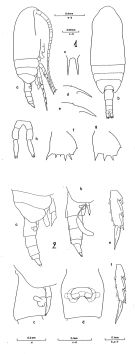 issued from : B. Frost & A. Fleminger in Bull. Scripps Inst. Oceanogr. Univ. California, San Diego, 1968, 12. [Pl. 56, p.212-213; Pl.57, p.214-215]. Female: 1 a, habitus (right lateral view); 1 b, idem (dorsal view); 1 c, rostrum (anteroventral); 1 d-e, rostrum (right lateral view); 1 f, B2 of P2; 1 g, B2 of P3; 1 h, P5; 1 a-b from different specimens; 1 c-d from a third specimen; 1 e (fourth specimen); 1 f-g from a fifth; 1 h from a sixth specimen; 2 a, Th.2 (posterior part), Th.3, Th.4-5, and urosome (right lateral view); 2 b, Th.4-5 (posterior part) and genital segment (right lateral); 2 c, Th.4-5 (posterior part) and genital segment (right lateral); 2 d, genital segment (ventral view); 2 e, Re3 and St of P3; 2 f, Re3 and St ofP4; 2 e-f taken from same specimen; 2 a-d allfrom different specimens. Nota:Caudal ramus more than 1.52 times as long as wide. A1 segment 2 more than 1.40 times as long as segment 24.
|
 issued from : B. Frost & A. Fleminger in Bull. Scripps Inst. Oceanogr. Univ. California, San Diego, 1968, 12. [Pl. 58, p.216-217; Pl.59, p.218-219]. Male: 1 a, habitus (right lateral view); 1 b, idem (dorsal view); 1 c, frontal region (right lateral); 1 d, urosome ( armature of caudal rami incomplete) (dorsal view); 1 e, B2 of P2; 1 f, B2 of P3; 1 a-b takenn from same specimen; 1 c from another; 1 d from a third ; 1 e-f from a fourth.; 2 a, Th.4-5 (posterior part) and urosome (right lateral view); 2 b, P5 (posterior); 2 c, P5 (right lateral); right P5; 2 a-d taken from different specimens. Nota: Longer ramus of P5 much shorter than urosome.
|
 issued from : J.M. Bradford-Grieve in The Marine Fauna of New Zealand: Pelagic Calanoid Copepoda. National Institute of Water and Atmospheric Research (NIWA). New Zealand Oceanographic Institute Memoir, 102, 1994. [p.108, Fig.60]. Female: A, habitus (dorsal); B, idem (lateral left side); C, right caudal ramus (dorsal); D, genital somite (lateral left side); E, rostrum (lateral and frontal views, respectively); F, A1; G, A2; H, Md; I, masticatory edge of Md; J, Mx1; K, Mx2.
|
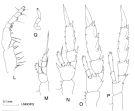 issued from : J.M. Bradford-Grieve in The Marine Fauna of New Zealand: Pelagic Calanoid Copepoda. National Institute of Water and Atmospheric Research (NIWA). New Zealand Oceanographic Institute Memoir, 102, 1994. [p.109, Fig.60 (overleaf)]. Female: L, Mxp; M, P1; N, P2; O, P3; P, P4; Q, P5.
|
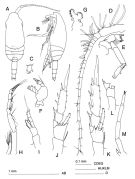 issued from : J.M. Bradford-Grieve in The Marine Fauna of New Zealand: Pelagic Calanoid Copepoda. National Institute of Water and Atmospheric Research (NIWA). New Zealand Oceanographic Institute Memoir, 102, 1994. [p.110, Fig.61]. Male: A, habitus (dorsal); B, idem (lateral left side); C, left caudal ramus (dorsal); D, A1; E, A2; F, Md; G, Mx1; H, Mx2; I, P1; J, P2; K, P3; L, P4 (incomplete); M, P5
|
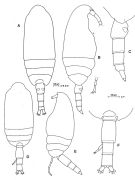 Issued from: M.G. Mazzocchi, G. Zagami, A. Ianora, L. Guglielmo & J. Hure in Atlas of Marine Zooplankton Straits of Magellan. Copepods. L. Guglielmo & A. Ianora (Eds.), 1995. [p.149, Fig.3.25.1]. Female: A, habitus (dorsal); B, idem (lateral right side); C, urosome (lateral right side). Nota: A1 reaching end of genital somite. Proportional lengths of urosomites and furca 35:23:18:10:14 = 100. Seminal receptacle conspicuous in ventral view. 3rd segment of P5 more than 2 times as long as 1st segment, terminal points spinulated along both margins. Male: D, habitus (dorsal); E, idem (lateral left side); F, urosome (dorsal). Nota: Proportional lengths of urosomites and furca 7:41:21:18:3:10 = 100. left P5 much shorter than urosome.
|
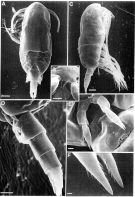 Issued from: M.G. Mazzocchi, G. Zagami, A. Ianora, L. Guglielmo & J. Hure in Atlas of Marine Zooplankton Straits of Magellan. Copepods. L. Guglielmo & A. Ianora (Eds.), 1995. [p.150, Fig.3.25.2]. Female (SEM preparation): A, habitus (dorsal); B, rostrum; C, habitus (lateral right side); D, urosome (lateral left side); E, P5; F, detail of terminal points of P5. bars: A, C 0.100 mm; B, D 0.050 mm; E 0.050 mm; E 0.010 mm; F 0.001 mm.
|
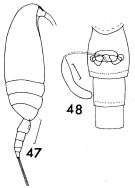 issued from : F.C. Ramirez in Contr. Inst. Biol. mar., Buenos Aires, 1969, 98. [p.50, Lam. VIII, figs.47, 48]. Female (from off Mar del Plata): 47, habitus (lateral right side); 48, urosome with spermatophore (ventral). Scale bars in mm: 0.1 (47); 0.05 (48).
|
 issued from : B. Frost & A. Fleminger in Bull. Scripps Inst. Oceanogr. Univ. California, 1968, 12. [p.78, Table 4a]. Clausocalanus brevipes Females: Measurements and ratios . TL = total body length ; SL = spermatophore length ; P :U = ratio of prosome length to urosome length ; U :U1 = ratio of total urosome length to length of 1st urosomal segment (genital segment) ; S :U1 = ratio of spermatophore sac length to U1 length of female on which spermatophore is attached ; r = sample range; m = sample mean; n = number of specimens measured; s = sample standard deviation.
|
 issued from : B. Frost & A. Fleminger in Bull. Scripps Inst. Oceanogr. Univ. California, 1968, 12. [p.79, Table 4b]. Clausocalanus brevipes Males: Measurements and ratios . TL = total body length; P :U = ratio of prosome length to urosome length ; P:U2 = ratio of prosome length to length od 2nd urosomal segment; U2:2P5 = ratio of U2 length to length of 2nd segment of longer ramus of P5; U2:3P5 = ratio of U2 length of 3rd segment of longer ramus of P5; 3P5:2P5 = ratio of length of 3P5 of longer ramus to length of 2P5 of longer ramus; r = sample range; m = sample mean; n = number of specimens measured; s = sample standard deviation.
|
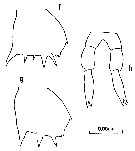 issued from : B. Frost & A. Fleminger in Bull. Scripps Inst. Oceanogr. Univ. California, 1968, 12. [p.213, Pl.56, f, g, h]. Female: f, basipodite 2 of P2; g, basipodite 2 of P3; h, P5 (from different specimen).
|
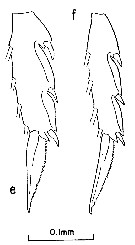 issued from : B. Frost & A. Fleminger in Bull. Scripps Inst. Oceanogr. Univ. California, 1968, 12. [p.215, Pl.57, e, f]. Female: e, exopodal segment 3 and terminal seta of P3; f, exopodal segment 3 and terminal seta of P4.
|
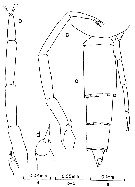 issued from : B. Frost & A. Fleminger in Bull. Scripps Inst. Oceanogr. Univ. California, 1968, 12. [p.219, Pl.59, a, b-c, d]. Male: a, posterior part of last thoracic segment and urosome (right lateral); b, P5 (posterior); c, P5 (right lateral); d, right P5. From different specimens.
|
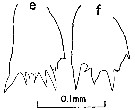 issued from : B. Frost & A. Fleminger in Bull. Scripps Inst. Oceanogr. Univ. California, 1968, 12. [p.217, Pl.58, e, f]. Male: e, basipodite 2 of P2; f, basipodite 2 of P3.
|
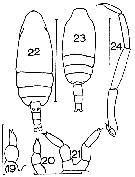 issued from : J.M. Bradford in Mem. N. Z. Oceonogr. Inst., 1972, 54. [p.35, Fig.5 (19-24)]. As Clausocalanus arcuicornis. Female (from Kaikoura, New Zealand): 19, P5; 20 (? parasited female); 21, P5; 22, habitus (dorsal). Male: 23, habitus (dorsal); 24, P5.
Scale bars: 1 mm (22, 23); 0.1 mm (19, 20, 21, 24).
Nota: For J.M. Bradford this form is C. brevipes (pers. comm.). For the author the opaque swollen appearance of the cephalothorax in some specimens suggests that this species may frequently be parasited. One such large (1.8 mm) opaque female did not have a fully developed genital segment, and the P5 had retained the juvenile proportions. Sewell (1951) found that C. arcuicornis in the Arabian Sea parasited by Blastodinium sp. were reduced in size, had modified P5, and an incompletely developed abdomen.
|
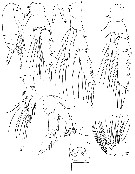 issue from : Heron G.A. & Bowman T.E. in Biology of the Antarctic Seas IV. Antarct. Res. Ser. Washington, 1971, 17. [p.160, Figs.116-124]. Female (from Arctic area): 116, habitus (lateral; scale bar: A); 117, genital field (scale bar: B); 118, right A2 (scale bar: B); 119, left Mx2 (scale bar: B), 121-123, P1 to P4 (scale bar: B); 124, P5 (scale bar: B). All scales in mm.
|
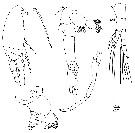 issue from : Heron G.A. & Bowman T.E. in Biology of the Antarctic Seas IV. Antarct. Res. Ser. Washington, 1971, 17. [p.160, Figs.125-129]. Male: 125, habitus (lateral; P4 missing; scale bar: A); 126, left A2 (scale bar: B); 127, right Md (scale bar: B); 128, P1 (scale bar: B); 129, P5 (scale bar: B). All scales in mm.
|
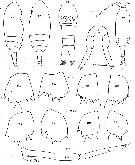 Issued from : C. Séret in Thesis UPMC, Paris 6. 1979. Annexe. [Pl. VI]. Female (from 46°-50°S, 51°-70°E): 21-22, habitus (dorsal and lateral, respectively); 23, urosome (ventral); 24, basipod of P2; 25, Basipod of P3; 26, P5. Male: 27, habitus (dorsal); 28, basipod of P2; 29, basipod of P3; 30, P5. Nota: Length of abdominal segments and caudal rami in the ratio 35 : 23 : 17 : 10 : 15 = 100. Genital segment slightly longer than wide. Caudal rami 1.7 times longer than wide. The author notes a difference between the disposition and number of teeth on basis of P2 male in Frost & Fleminger (1968), 3 teeth here against 7 in Frost & Fleminger.
|
 Issued from : C. Séret in Thesis UPMC, Paris 6. 1979 [p.52]. Female (from off N Kerguelen Is.): Relative lengths (%) of abdominal segments and furca (= caudal rami)
|
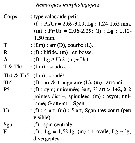 Issued from : C. Razouls in Ann. Inst. océanogr., Paris, 1994, 70 (1). [p.44]. Caractéristiques morphologiques de Clausocalanus brevipes femelle et mâle adultes. Terminologie et abbréviations: voir à Calanus propinquus. Nota: Peut être confondu avec Clausocalanus parapergens, cette dernière forme tropicale et subtropicale. alors que C. brevipes semble une forme des eaux subantarctiques, observée entre les latitudes 40-60° S.
Les stades copépodites 1 à 5 sont décrits par Heron et Bowman (1971, p.145-157).
| | | | | Compl. Ref.: | | | Björnberg, 1973 (p.311, 385); Santos & Ramirez, 1991 (p.79, 80, 82, 83); 1995 (p.133, Tabl. I, fig.2); Errhif & al., 1997 (p.422); Razouls & al., 2000 (p.343, tab. 3, 5, Appendix); Hunt & al., 2001 (p.374, tab.1, 2); Marrari & al., 2004 (p.667, tab.1); Hunt, 2004 (p.1, 47, 74, Table 3.2, 4.4, fig.4.7); Berasategui & al., 2005 (p.313, fig.2); Berasategui & al., 2005 (p.485, tab.1); Berasategui & al., 2006 (p.485: fig.2); Ward & al., 2006 (p.83: tab.4); Hunt & Hosie, 2006 (p.1203, tab.2, fig.8); Dias & Araujo, 2006 (p.39, Rem., chart); Biancalana & al., 2007 (p.83, Tab.2, 3); Rossi, 2008 (p.90: Tableau XII); Schnack-Schiel & al., 2008 (p.1045: Tab.2); Takahashi & al., 2010 (p.317, Table 3, 4, figs.5, 7); Swadling & al., 2010 (p.887, Table 2, 3, A1, fig.6, abundance, indicator species); Padovani & al., 2011 (p.205, occurrence); Pillai H.U.K. & al., 2011 (p.239, Table 3, vertical distribution); Guglielmo & al., 2012 (p.1301, Table 3); Sabatini & al., 2012 (p. 33, Table 3, abundance vs stations transect); Michels & al., 2012 (p.369, Table 1, occurrence frequency); Aguirre & al., 2012 (p.341, Table I: abundance vs season, fig.4); Bonecker & a., 2014 (p.445, Table II: frequency, horizontal & vertical distributions); Acha & al., 2020 .p.1, Table 3: occurrence % vs ecoregions, Table 5: indicator ecoregions). | | | | NZ: | 6 + 1 doubtful | | |
|
Distribution map of Clausocalanus brevipes by geographical zones
|
| | | | | | | | | | | | 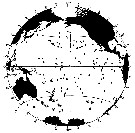 issued from : B. Frost & A. Fleminger in Bull. Scripps Inst. Oceanogr. Univ. California, San Diego, 1968, 12. [p.72, Chart 11, a]. issued from : B. Frost & A. Fleminger in Bull. Scripps Inst. Oceanogr. Univ. California, San Diego, 1968, 12. [p.72, Chart 11, a].
Occurrence of C. brevipes in samples examined; closed circles represent samples examined; open circles represent samples in which adults were found; bars through open circles represent samples from which specimens were removed for measurements. |
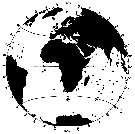 issued from : B. Frost & A. Fleminger in Bull. Scripps Inst. Oceanogr. Univ. California, San Diego, 1968, 12. [p.73, Chart 11, b]. issued from : B. Frost & A. Fleminger in Bull. Scripps Inst. Oceanogr. Univ. California, San Diego, 1968, 12. [p.73, Chart 11, b].
Occurrence of C. brevipes in samples examined; closed circles represent samples examined; open circles represent samples in which adults were found; bars through open circles represent samples from which specimens were removed for measurements. |
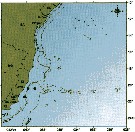 issued from : C. de O. Dias & A.V. Araujo in Atlas Zoopl. reg. central da Zona Econ. exclus. brasileira, S.L. Costa Bonecker (Edit), 2006, Série Livros 21. [p.39]. issued from : C. de O. Dias & A.V. Araujo in Atlas Zoopl. reg. central da Zona Econ. exclus. brasileira, S.L. Costa Bonecker (Edit), 2006, Série Livros 21. [p.39].
Chart of occurrence in Brazilian waters (sampling between 22°-23° S).
Nota: sampling only 9 specimens. |
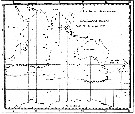 Issued from : C. Séret in Thesis 3ème Cycle, UPMC, Paris 6. 1979, Annexe. [p.25]. Issued from : C. Séret in Thesis 3ème Cycle, UPMC, Paris 6. 1979, Annexe. [p.25].
Geographical occurrences of Clausocalanus brevipes in the Indian Ocean and Antarctic zone. [after publications from: Brady, 1883, 1918; Thompson, 1900; Wolfenden, 1908, 1911; With , 1915; Rosendorn, 1917; Farran, 1929; Sewell, 1929, 1947; Brady & Gunther, 1935; Steuer, 1929, 1392, 1933; Ommaney, 1936; Vervoort, 1957; Tanaka, 1960; Brodsky, 1964; Seno, 1966; Andrews, 1966; Grice & Hulsemann, 1967; Seno, 1966; Frost & Fleminger, 1968; Voronina, 1970; Zverva, 1972].
C. Séret notes the occurrence at stations 46°S, 51°E; 46°S, 64°E; 50°S, 70°E. |
 Issued from : K.M. Swadling, So. Kawaguchi & G.W. Hosie in Deep-Sea Research II, 2010, 57. [p.897, Fig.6 (continued)]. Issued from : K.M. Swadling, So. Kawaguchi & G.W. Hosie in Deep-Sea Research II, 2010, 57. [p.897, Fig.6 (continued)].
Distribution of indicator species Clausocalanus brevipes from the BROKE-West survey (southwest Indian Ocean) during January-February 2006.
Sampling with a RMT1 net (mesh aperture: 315 µm), oblque tow from the surface to 200 m.
The survey area was located predominantly within the seasonal ice zone, and in the month prior to the survey there was considerable ice coverage over the western section but none over the east.
See map showing sampling sites in Calanus propinquus. |
| | | | Loc: | | | Antarct. (Weddell Sea, Indian, SW Pacif.), Beagle Channel, Strait of Magellan, sub-Antarct. (off W Prince Edward, Indian, SW & SE Pacif.), S Indian (subtropical convergence), Andaman Sea (Barren Island in Pillai & al., 2011), New Zealand (S, Kaikoura, E), Chile, Ushuaia, Straits of Magellan, Malvinas current, Patagonia, Peninsula Valdés, off Mar del Plata, Brazil (S, Vitoria-Cabo de Sao Tomé), ? NW Medit. (Toulon harbour) (in Rossi, 2008 (p.90: Tableau XII) | | | | N: | 39 ? | | | | Lg.: | | | (30) F: 1,62-1,24; M: 1,27-1,12; (36) F: 1,8-1,47; M: 1,59-1,27; (246) F: 1,6-1,37; M: 1,31; (371) F: 1,54-1,41; M: 1,5-1,34; {F: 1,24-1,80; M: 1,12-1,59}
The mean female size is 1.506 mm (n = 8; SD = 0.1729), and the mean male size is 1.343 mm (n = 7; SD = 0.1566). The size ratio (male : female is 0.89 (n = 4; SD = 0.0533). | | | | Rem.: | epipelagic. Shelf and oceanic.
Sampling depth (Antarct.) : 0-600 m.
For Frost & Fleminger (1968, p.71) the females are very similar to C. parapergens; they are distinguished by the length-width ratio of the caudal ramus and the length ratio of A1 segment 2 to segment 24. C. brevipes females differ from furcatus in the appearance of the seminal receptacle in lateral view, the relative lengths of Urosomal segments 1 and 3, and the Urosome/Urosomal segment 1 length ratio. Males of C. brevipes are easily distinguished from all other species of Clausocalanus by the length of the longer (left) ramus of the P5 relative to the Urosome. The name brevipes refers to the unique male characteristic of having the longer ramus of P5 shorter than the Urosome.
Bradford (1972, p.36) points to the opaque swollen appearance of the cephalothorax in some specimens suggests that this species may frequently be parasited. One such large (1.8 mm) opaque female did not have a fully developed genital segment, and the P5 had retained the juvenile proportions | | | Last update : 17/06/2021 | |
|
|
 Any use of this site for a publication will be mentioned with the following reference : Any use of this site for a publication will be mentioned with the following reference :
Razouls C., Desreumaux N., Kouwenberg J. and de Bovée F., 2005-2025. - Biodiversity of Marine Planktonic Copepods (morphology, geographical distribution and biological data). Sorbonne University, CNRS. Available at http://copepodes.obs-banyuls.fr/en [Accessed January 01, 2026] © copyright 2005-2025 Sorbonne University, CNRS
|
|
 |
 |

























